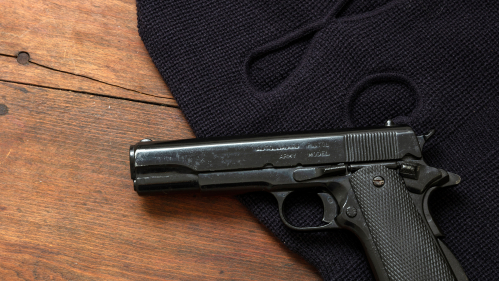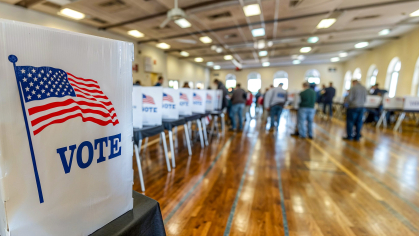New Jerseyans Are Divided On Whether Firearms Increase Protection From Intruders in the Home

Residents also are divided whether the presence of these arms raises the risk of suicide or an unintentional shooting, despite research showing clear increase
When it comes to firearms in the home, New Jerseyans are divided on how helpful they perceive them to be for protection compared to the risks they pose, according to the latest Rutgers-Eagleton Poll in partnership with the New Jersey Gun Violence Research Center.
Thirty-two percent of residents polled in December 2023 think storing a firearm in one's home as a tool doesn’t lower the risk of an intruder coming in and hurting someone in their household, 18 percent think it only slightly lowers the risk, 20 percent think it moderately lowers the risk, and 25 percent think it greatly lowers the risk. Five percent are unsure.
New Jerseyans are mixed not only on how much protection a firearm in the home offers, but on how risky it is for the household members who live in a residence where a gun is present. Thirty-three percent say a firearm in one's home doesn’t increase the risk at all that someone in their home will die by suicide or unintentionally shoot themselves or someone else with that firearm, 23 percent say it slightly increases the risk, 13 percent say it moderately increases the risk, and 25 percent say it greatly increases the risk. Six percent are unsure.
“Although opinions may be divided about the risks involved in having firearms in the home, the data is clear on this issue,” said Michael Anestis, an associate professor in urban-global public health at the Rutgers School of Public Health and executive director of the New Jersey Gun Violence Research Center. “Having a firearm in the home dramatically increases the risk of suicide for all members of the household, while also increasing risk for unintentional shootings and fatal domestic violence. If firearm owners are not aware of this, they may not be taking the necessary precautions to help avoid those outcomes, like storing the firearm securely in the home and storing it legally away from home during times of stress. If a firearm is kept at home to keep people safe, firearm owners should make sure they are actually doing what is necessary to accomplish that goal.”
“There is a mismatch here between perception and reality,” said Ashley Koning, an assistant research professor and director of the Eagleton Center for Public Interest Polling (ECPIP) at Rutgers University–New Brunswick. “Public opinion alone tells a misleading story that departs from the actual statistics associated with suicide and unintentional shootings in homes with firearms, but what it does importantly tell us is the need to further educate the public on this matter.
Views on the benefits and risks of firearms in the home are divided by familiar demographic lines. Feelings on whether firearms lower the risk of a household member getting hurt by an intruder are highly partisan; two-thirds (65 percent) of Democrats believe it either slightly lowers the risk or doesn’t lower the risk at all, while two-thirds (62 percent) of Republicans believe the opposite. Women (55 percent), people in the highest income bracket (57 percent), and those who completed some type of graduate work (64 percent) are all more likely than their counterparts to believe a firearm in the home does little to nothing to lower the risk of an intruder harming someone in the household.
Those with a firearm in the home are more than one-and-a-half times more likely than those without one to say a firearm moderately or greatly lowers the risk of an intruder harming someone in their household (66 percent to 37 percent, respectively). Nearly half of residents with a firearm in the home (48 percent) believe a firearm greatly lowers the risk of harm done by an intruder, with Republicans coming in a close second (46 percent).
Similar patterns emerge when it comes to how much of a risk a firearm in a home is to household members, whether because of suicide or an unintentional shooting. Once again, partisans are on opposite sides – Republicans believe a firearm in the home minimally or doesn’t increase risk (78 percent). Democrats feel the opposite, with over half (55 percent) saying a firearm moderately or greatly increases this risk; Democrats are more divided than those across the aisle, however. Independents are somewhere in the middle, with 59 percent saying a firearm poses minimal or no risk.
Men (62 percent); people 50 to 64 years old (62 percent); residents living in the exurban (60 percent), southern (61 percent), or shore regions (63 percent); and those with lower levels of education (62 percent for those with a high school education or less and 61 percent for those with some college education) all say a firearm in the household minimally or doesn’t increase risk of harm to household members. Residents with a firearm in the household are the most adamant – 88 percent say this, compared with 46 percent of residents who don’t have a firearm in the household.
Nineteen percent of New Jerseyans report that one or more firearms are typically stored in or around their home. Firearms in the household are more common among Republicans (37 percent), men (26 percent), white residents (23 percent), middle-aged residents (21 percent of those 35 to 49 and 25 percent of those 50 to 64), those in higher income brackets (28 percent of those earning $100,000 to under $150,000 and 26 percent of those earning $150,000 or more), exurbanites (27 percent), those living near the shore (29 percent), and those with some college education (23 percent) or a four-year college degree (23 percent).
“Gun permits are rising in the Garden State, and our numbers within the past year have certainly reflected this,” Koning said. “Those reporting a firearm in or around their home has increased by almost 50 percent compared to the last time we polled this question prior to the pandemic.”
Results are from a statewide poll of 1,657 adults contacted through multiple modes, including by live interviewer on landline and cell phone, MMS text invitation to web and the probability-based Rutgers-Eagleton/SSRS Garden State Panel from Dec. 13 to Dec. 23. The full sample has a margin of error of +/- 2.8 percentage points. The registered voter subsample contains 1,451 registered voters and has a margin of error of +/- 3.0 percentage points.


